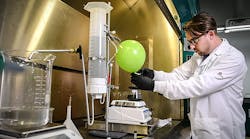Metamaterials are often valued for their high performance as circuit substrates, although the U.S. Army Research Laboratory (ARL) recently discovered that certain metamaterials can also serve as a source of energy. The aluminum metamaterial developed by ARL releases energy when it comes in contact with water or any liquid containing water. The new metamaterial has the potential to be a starting point for batteries and portable power sources, which can be carried to a point of use and then activated by water from a convenient source.
The new metamaterial was discovered by U.S. Army scientists and researchers during routine experiments on different materials. The nano-galvanic aluminum-based metamaterial breaks apart the bonds between the two atoms of hydrogen and the atom of oxygen which form water (H2O), releasing energy and producing oxygen and hydrogen gases. The researchers discovered a bubbling reaction when adding water to the material. “We all as a team were very excited and ecstatic that something good had happened,” said Dr. Anit Giri, a physicist with the lab’s Weapons and Materials Research Directorate. The water molecules literally split apart when coming into contact with the aluminum nanomaterial.
Considering the large global supply of water, the researchers identified a number of benefits from the material and the reaction. For example, “the hydrogen that is given off can be used as a fuel in a fuel cell,” Scott Grendahl, a materials engineer and team leader, “What we discovered is a mechanism for a rapid and spontaneous hydrolysis of water.”
Catalysis of water has traditionally been performed by adding a catalyst to aluminum, over an extended period of time, at elevated temperatures, and with a great deal of electricity applied to foster the reaction. Traditional methods can also leave behind toxic chemicals as part of the reaction, including sodium hydroxide and potassium hydroxide. As Giri observed, this new catalysis process is attractive for its simplicity. “In our case, it does not need a catalyst,” he said. “Also, it is very fast. For example, we have calculated that 1 kg of aluminum powder can produce 220 kW of energy in just 3 minutes.
“These rates are the fastest known without using catalysts such as an acid, base, or elevated temperatures,” Giri added.
In terms of in-field use, the discovery may well lead to the development of new battery technologies that enable troops to take advantage of longer run times for portable, battery-powered equipment, such as two-way radios. “These teams are out for a short number of days—three to five days—and a lot of that depends not only on their food supplies, but on how long their supplies last in terms of their equipment,” said Grendahl. “And right now, that stems from lithium batteries. If we can recharge those batteries, they can stay out longer.”
Experiments were performed on the use of the catalytic energy-producing reaction for different applications. In one, a small radio-controlled tank was powered by the aluminum-powder/water reaction. After the electricity from that reaction was exhausted, the hydrogen was used to power the radio-controlled tank model.

